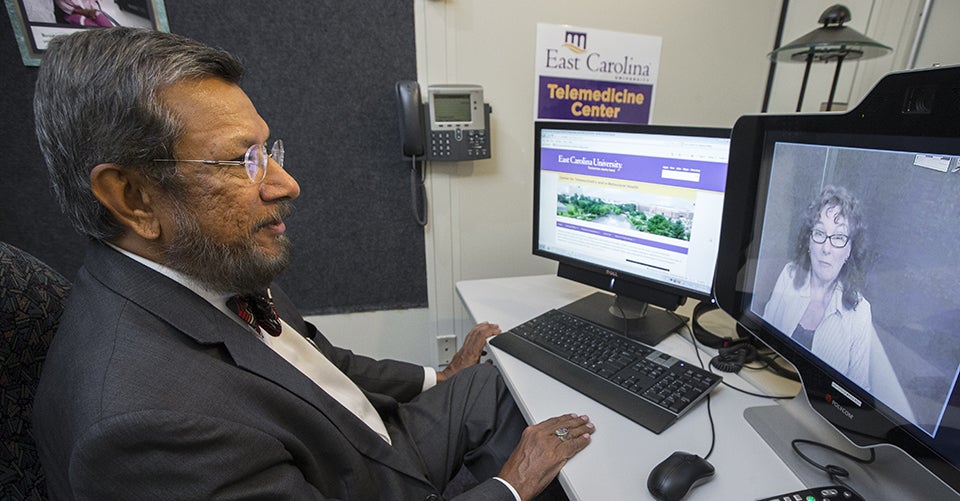RESTORING LIVES
ECU telepsychiatry reaches patients across North Carolina
In any industry, the quality of service or whether one receives services at all hinges on one critical element: access. For those needing mental health services, the North Carolina Statewide Telepsychiatry Program, or NC-STeP, offers unprecedented access through an innovative delivery system connecting qualified doctors to mental health and substance abuse patients who sorely need their help. It is altering the landscape of psychiatric treatment and availability in the state.
NC-STeP provides expert psychiatric assessments and consultations through a network of 80-plus hospitals statewide. Those hospital emergency departments use telemedicine technologies—secure, real-time interactive audio and video technology at the bedside—to treat patients in rural and underserved areas. NC-STeP’s level of reach has enabled over 21,000 patient encounters. As a result, emergency departments have seen shorter lengths of stay, fewer involuntary commitments, less recidivism, and most importantly, measurable cost savings. Established through state legislation in 2013 with $2 million annually, NC-STeP is administered by the East Carolina University Center for Telepsychiatry and E-Behavioral Health (CTeBH), and is overseen by the DHHS Office of Rural Health.
“This $2 million dollar investment from the state has generated five to six million in cost savings when you consider that forty percent of patients have been sent home and connected to a community provider. It prevents unnecessary hospitalization,” says Dr. Sy Saeed, M.D., the director of both NC-STeP and CTeBH.
How does the system work? A nurse at the remote referring site rolls a portable cart outfitted with a monitor, camera, and microphone into the patient’s bay or room, establishes a secure link to the psychiatric provider site, and introduces the patient to a psychologist or social worker who has reviewed the patient’s information. Once that individual explores the patient’s situation and gathers any pertinent information from family members, a psychiatrist interviews the patient and makes recommendations to the referring hospital physician, who is ultimately responsible for care decisions.
Saeed points out that today’s emergency departments are jammed, especially in North Carolina due to mental health reform and the dismantling of the community-based system. The public may be surprised to learn that the emergency department arrivals are not, as often thought, using the facilities in place of a standard doctor’s visit.
“Contrary to the myth that people go to the emergency department for convenience, we have found that this is a sick and severely decompensated population. Their illnesses run the gamut from acute depression with suicidal thoughts to severe psychotic exacerbations of schizophrenia to manic episodes. Some cases are substance induced. Others suffer severe anxiety or panic,” explains Saeed.
Thanks to NC-STeP, about one-quarter of the patients to arrive at an emergency department with involuntary commitment orders get those orders overturned. According to Saeed, times have never been better for mental health patients because more effective, evidence-based care is available. People are recovering and able to enjoy family relationships and employment. The drawback remains accessibility to good care among rural populations, but Saeed and his team are working to broaden the reach. He says, “Telepsychiatry fills gaps with what science has promised them. They now have emergency intervention and access to professional medical care. We’ve opened a door.”
Saeed initially had planned for 59 out of 108 hospitals in North Carolina, based on the number of facilities that had no ground psychiatric services available, making them ideal candidates. But the demand was greater. “Within three months,” he recalls, “we realized that 70 hospitals were interested. Word had gotten out by word-of-mouth, press articles and the usual channels. The legislature funded 59. We approached The Duke Endowment to fund over and beyond the legislature, and we were able to grow the program to over 80 hospitals.”
Finding providers is an ongoing challenge due to the nationwide shortage of psychiatrists, with underserved regions being the hardest hit. One doctor in 10,000 is the generally agreed upon number for psychiatrists. North Carolina statistics are even higher based on county-by-county level breakdowns. Twenty-nine of 100 counties have no practicing psychiatrist. Fifty-eight counties are regarded as Health Professional Shortage Areas due to the dearth of providers. One-third of the patients served by NC-STeP have no health insurance. Saeed and his team offer payment competitive with community mental health centers. Nevertheless, going up against the financial allure of private practice in metropolitan markets is difficult.
Asked where he would like to see the program go, Saeed answers that the big part of the journey remains. Ideally, he would like to see the program benefit from the cost savings it generates in order to address the shortage of mental health providers. He would like to build community-based locations in areas lacking access without competing with existing programs. Saeed contends that if appropriate health care can be delivered in the community setting, patients are less likely to end up in emergency departments.
Telepsychiatry is technology based and driven, yet it lengthens and strengthens the reach of the health care providers to patients they might not otherwise have an opportunity to engage. Says Saeed, “It helps retain the personal touch. It’s still a human connection. It’s still about building relationships, bridging distances, and making health care convenient for people.”

Dr. Sy Saeed, chair of the Brody School of Medicine’s Department of Psychiatry and Behavioral Medicine and director of the statewide NC-STeP program.
